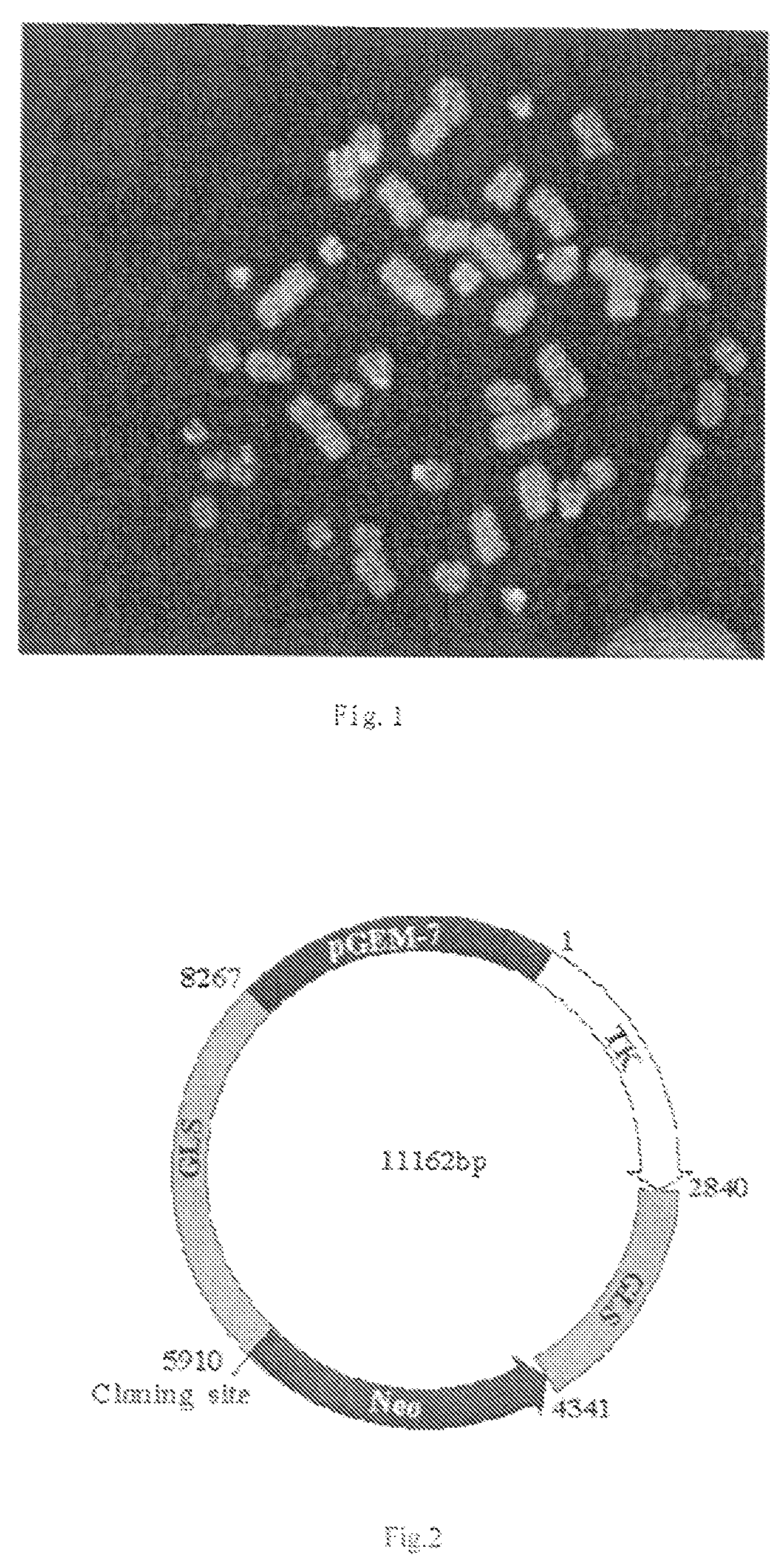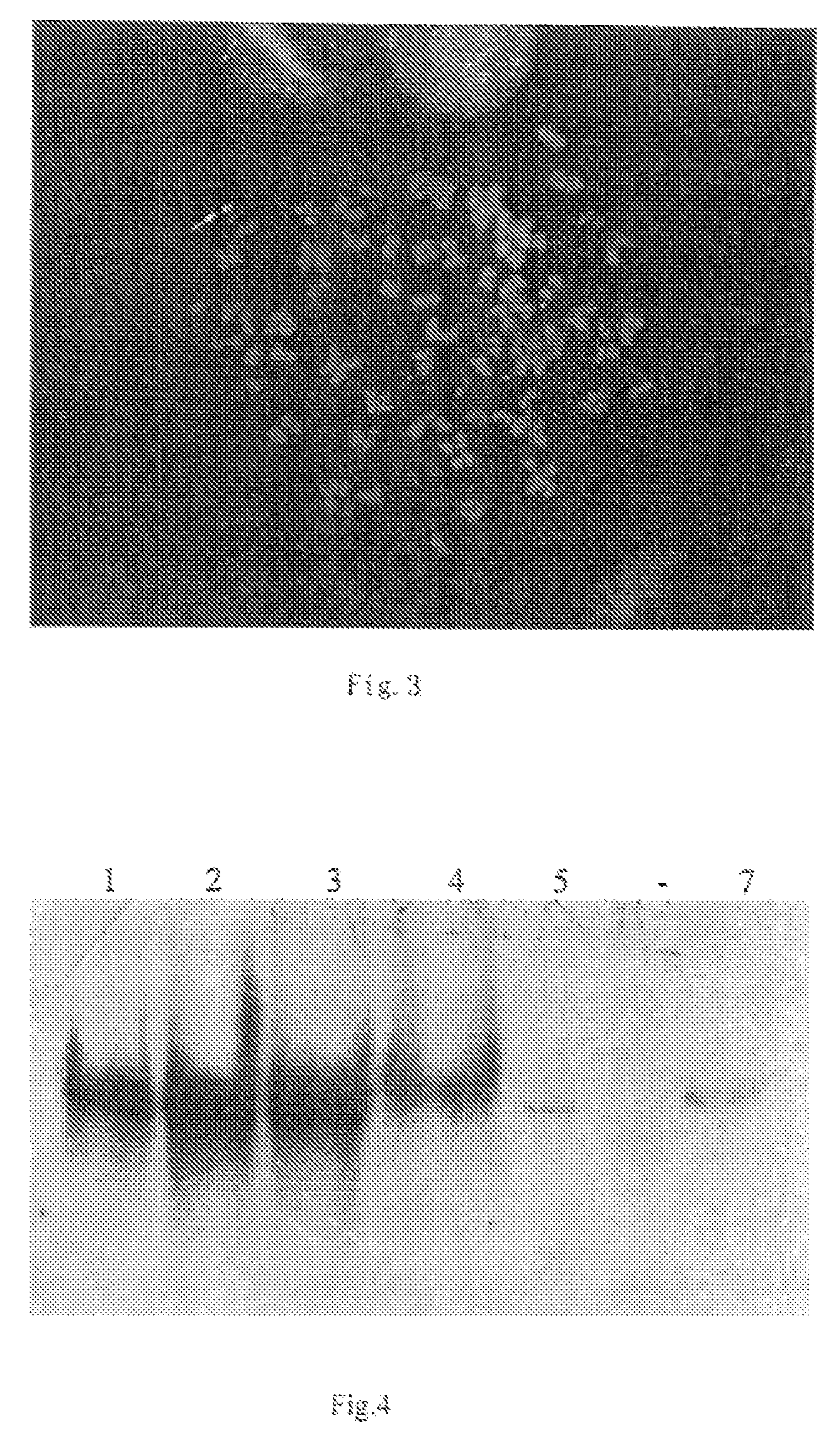Cell line expressing mutated human tissue-type plasminogen activator, the constructing strategy thereof and method of preparing expressed protein
a plasminogen activator and cell line technology, applied in the field of cell line expressing mutated human tissue-type plasminogen activator, the constructing strategy thereof and the method of preparing expressed protein, can solve the problem of fibrinolysis over all the body, and achieve the effect of low specificity, activity and efficacy further improved, and low specific affinity
- Summary
- Abstract
- Description
- Claims
- Application Information
AI Technical Summary
Benefits of technology
Problems solved by technology
Method used
Image
Examples
example 1
Preparation of a Gene Targeting Sequence of the Invention
[0018]1 Isolation of PAC Clone with Gene Targeting Sequence[0019]1.1 Construct BM specific pUC19 library through micro-dissection, PCR, microcloning (Deng H-X, Yoshirua K, Dirks R W, et al. Hum Genet 1992,89:13.)[0020]1.2 Identification of BM Specific Single Copy DNA
[0021](1) preparation of colony matrix membrane: draw 14×12 square wells on two nylon membranes, labeled as A and B, and put into two plates with solid LB, respectively, then pick white clones randomly from library plates and inoculate to the 14×12 square wells of two membranes with same coordinate, add 100 ng single copy DNA to the 13th line as positive control, and then add 100 ng gDNA to 14th line as negative control. Two plates are incubated for 10˜12 hours at 37° C., and membrane B is stored at 4° C. Remove membrane A from plate, and treat on a filter paper soaked by following solution: 10% SDS, 5 minutes, 0.5N NaOH / 1.5M NaCl, 3 minutes, 1.5M NaCl / 0.5M Tris.HC...
example 2
Preparation of Gene Vector of the Invention
[0036]1. The Construction of Gene Vector and Induction of Target Gene
[0037]1.1 Construct Gene Vector
[0038]1.1.1 Nsi I and Stu I (blunt enzyme) digest PAC DNA, run the sample on a common agarose gel, recover the 3.8 kb DNA and purify the DNA by electric elution.
[0039]1.1.2 pGEM-TK vector DNA is digested with Hind III, and then digested with Klenow further to generate the blunt ends.
[0040]1.1.3 The blunt ends of pGEM-TK / Hind III is further digested with Nsi I.
[0041]1.1.4 The purified 3.8 kb / Nsi I+Stu I digested DNA and the Nsi I digested pGEM-TK are ligated for 17 hours at 16° C.
[0042]1.1.5 The ligated product is transformed into JM109 competent bacteria, culture 19 hours at 37° C. in an ampicillin plate.
[0043]1.1.6 Randomly pick single clones and identify the positive clones with Nsi I and Nhe I double digestion.
[0044]1.1.7 The plasmid pCDN-GPR is digested with Xba I and Nhe I to acquire the XbaI+NheI digested Neo gene.
[0045]1.1.8 Construct ...
example 3
[0076]Transfer the recombinant vector-TNK-TPK acquired in the example 2 into host cell HT1080, obtain the required cell lines after screening, and express in vitro, confirms site-directed integration and high efficiency expression.
[0077]1 Material[0078]1.1 Cell: HT1080
[0079]Culture Medium: High Sugar DMEM+10% FBS(HT1080) EMEM+10% FBS[0080]1.2 Electroporation apparatus: purchased from Bio-Rad Company.
[0081]2. Methods[0082]1) Culture the cells in a 75 cm2 culture bottle to 70%˜80% confluence.[0083]2) Harvest the cells and wash with HeBs Buffer for two times, then account the cells.[0084]3) Centrifuge at 15000 rpm at 4° C. for 10 min.[0085]4) Resuspend the cells with a reasonable volume of HeBS Buffer to make the cell density to 106˜107 / ml.[0086]5) Add 0.8 ml suspension (about 10 μg DNA vector) to an 0.4 cm electroporation cuvette[0087]6) Electroporate the suspension, parameters: 260V, 550 uF for 11˜13 ms.[0088]7) Transfer the shocked cells to a 75 cm2 culture flask, add 14 ml culture ...
PUM
| Property | Measurement | Unit |
|---|---|---|
| temperature | aaaaa | aaaaa |
| temperature | aaaaa | aaaaa |
| temperature | aaaaa | aaaaa |
Abstract
Description
Claims
Application Information
 Login to View More
Login to View More - R&D
- Intellectual Property
- Life Sciences
- Materials
- Tech Scout
- Unparalleled Data Quality
- Higher Quality Content
- 60% Fewer Hallucinations
Browse by: Latest US Patents, China's latest patents, Technical Efficacy Thesaurus, Application Domain, Technology Topic, Popular Technical Reports.
© 2025 PatSnap. All rights reserved.Legal|Privacy policy|Modern Slavery Act Transparency Statement|Sitemap|About US| Contact US: help@patsnap.com


